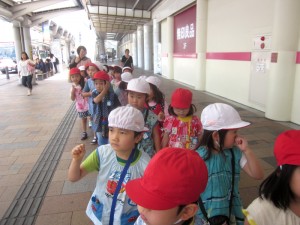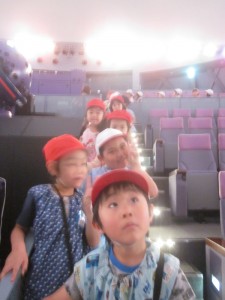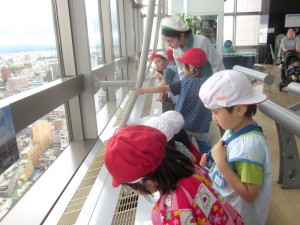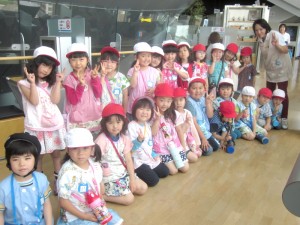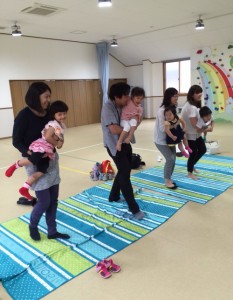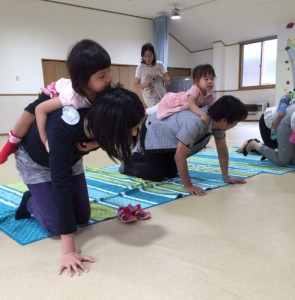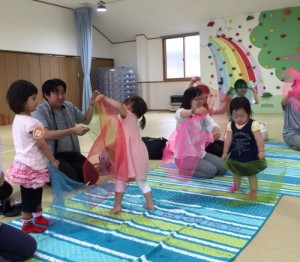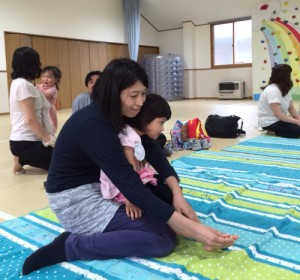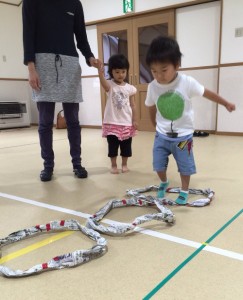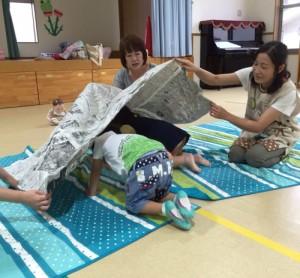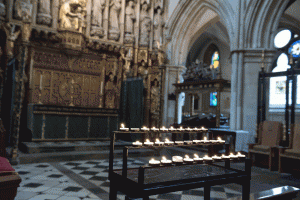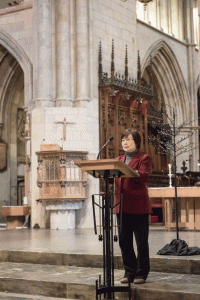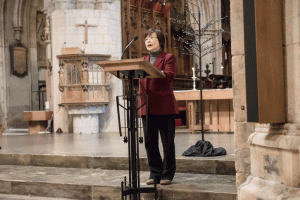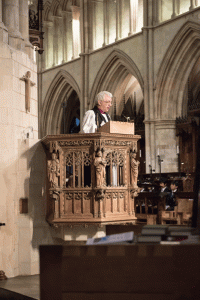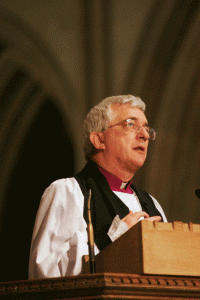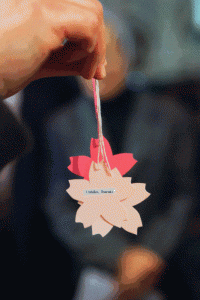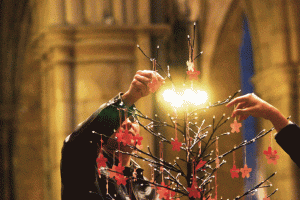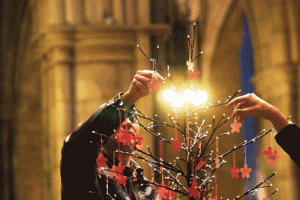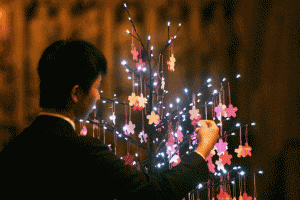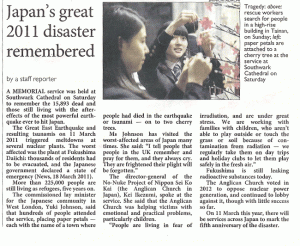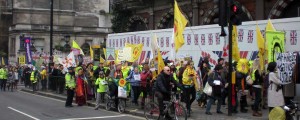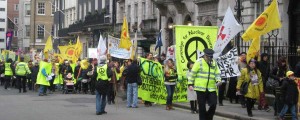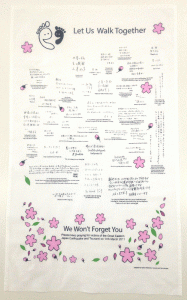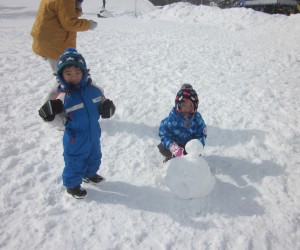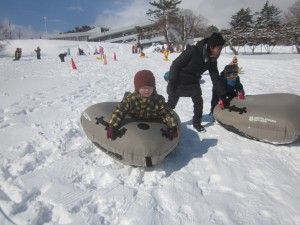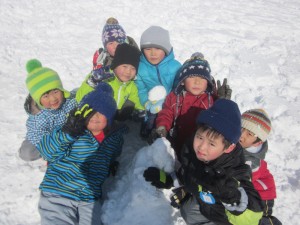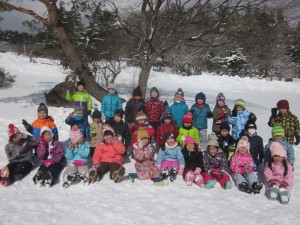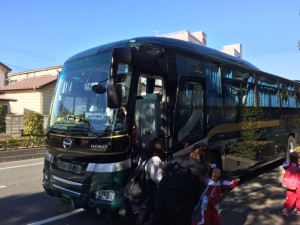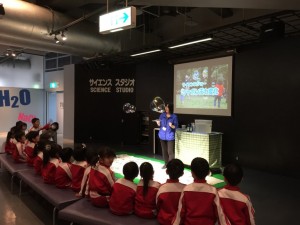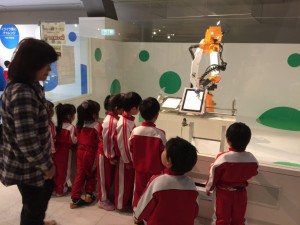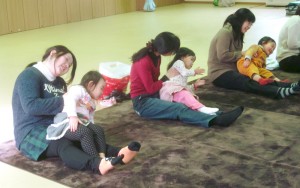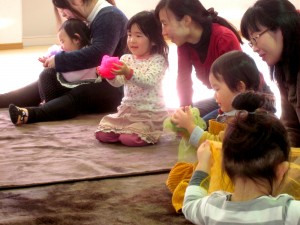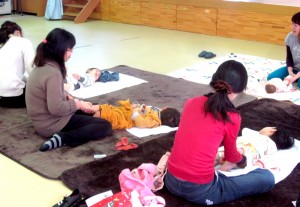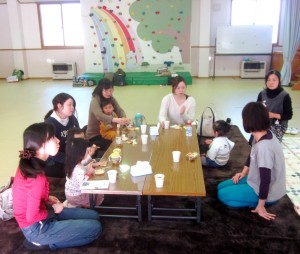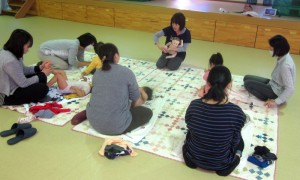Original Japanese written by staffer
The English below written and arranged by Heeday, based on the original Japanese
The English edited by Rev. Dr. Henry French, ELCA
On Friday, March 11th, 2016, the Tohoku Diocese, Anglican-Episcopal Church in Japan, held a “Eucharist and meditation to commemorate the East Japan Earthquake after five years.”
The participants, thinking of all those who are still struggling with many difficulties in the aftermath of the March 2011 disaster, said requiem prayers for those killed in the tsunami-earthquake tragedies. During a time of meditation, they listened to stories told by three people hard hit by the disaster. One of the three, a staffer of our Project, told the story below:
The story
On March 11th, 2011, soon after the earthquake and tsunami, no one had any hope for tomorrow in the darkness of the hard-hit areas. The earthquake, tsunami, and nuclear meltdown devastated much of the Tohoku region. Back then, no one would have imagined that the region would be rebuilt to what it is today in 2016. We owe this recovery to the countless people who have walked together with us.
Still, we have many very difficult problems, for instance, the Fukushima Daiichi meltdown, and radioactive contamination. We have yet to see any solution to these problems. As time goes by, these tragedies can fade from the memories of many, leaving numerous victims forgotten and unattended.
Torn apart
On the day the disaster hit, I was living in Sendai, Miyagi (some 95 miles NNE of Koriyama), while my husband was in Koriyama, Fukushima. The disaster destroyed essential utilities, and phone service was mostly unavailable. I simply was unable to find out how my husband was. I was utterly upset. Also, media reports on the Fukushima Daiichi accident were growing worse day by day. In short, the whole situation was getting worse and worse.
Five days after the earthquake, the US government specified Koriyama, where my husband was, as an evacuation zone, while Japan’s own government gave no such instructions to evacuate. The Japanese government thus proved that it was not seriously concerned with the lives of its own citizens. Thus, all of us in the affected areas were left to make our own decision as to stay or leave. Overwhelmed by fears, I managed to contact my husband and begged him to leave, even at the cost of his employment. So, he fled Fukushima before his office issued an evacuation instruction.
Today, “the daily routine” has come back to us, here in Tohoku, yet I sometimes suspect my husband is now paying a price for his evacuation. Maybe I should not have asked him to flee back then—I still blame myself for that.
Reunited
To the surprise of many around me, four months after the disaster, I moved out of Sendai to Koriyama, to be with my husband who had returned there by then. They asked me, “Why on earth are you moving into that dangerous place!?” and “Why is it your family does not stop you!?” The answer was simple. I just could not stand leaving my beloved husband alone in the middle of radioactive danger, while I was in a much safer place. I felt so guilty. Ever since I came to Fukushima, I have been living with tension, carefully trying to avoid the invisible demon called radioactivity. I keep my windows shut, and am quite careful with what I eat and drink in order to prevent exposure to radiation. Meanwhile, my husband seems to have given up on such efforts and does not care about radiation anymore.
So, recently, he walks around without a mask even in the middle of a highly radioactive place. I cannot say anything about it, since I know that, given his situation, he just cannot live in a place like this if he is always worried about radiation exposure. In and out of home, radiation is a taboo topic here. With no “right” solution available, every one here has to set his/her own rules. Once you have decided to live here, you have to learn about radiation protection on your own, and make some compromises. Back in 2011, “kizuna” (ties or bonds) was a hot Japanese word all over the nation. The greatest relief I had were the ties I had with friends sharing the same sufferings.
And now —
Today, five years after the earthquake, here in Koriyama, where I am still living, a calm “daily routine” seems to be back, having replaced the craziness that followed the disaster. Actually, however, everyone living here remains more or less anxious about radiation.
Chanting “safety” and the invisible demon
In its efforts to rebuild Fukushima and bring people back there, Japan’s government is chanting “safe, easy” to describe Fukushima. If you, however, carry a Geiger counter and take measurements here, you will find a value above 0.23 mSv/h—the threshold for decontamination work—almost everywhere. Moreover, we have hot spots here and there where the measurement exceeds 1 mSv/h. In spite of this, many school kids walk to school without wearing a mask, exposed to high radiation, and they run around the school yard where radioactive dust is in the air. For school lunches, the education board is recommending Fukushima’s own produce. Though many parents buy only food from outside Fukushima, they cannot alter the ingredients of school lunches. (Carrying handmade sandwiches from home to school would force the child to stand out during the lunch.) And these worries are so serious one cannot talk about them easily. Among neighborhood mothers and between children, if you show your concern over radiation, you will be excluded.
Thyroid cancers in children
The Fukushima Prefectural Government is sponsoring echo examinations of the thyroids of citizens who were 0 to 18 years in age when the earthquake hit. The examination is held every two years, until such people reach 20 years in age, and then every five years after that.
As of February, 2016, thyroid cancer has been detected in 116 children, with many children already having undergone an operation. This echo examination takes only 3 to 5 minutes a person, and many people line up to receive it; however, there is no detailed interview conducted before or after the examination. Thus, both the children and their parents worry if such examinations are good enough to detect a hidden health problem. And once such an examination is done, they have to wait two years for the next examination.
Lasting damages
If an examination finds cancer in an unlucky child, he/she has to have an operation, which leaves a scar on the neck. I am more worried, however, over psychological damage. That child, in the future, will have to confess that he/she received a thyroid cancer operation at every major occasion in his/her life, e.g., when he/she enters a university, gets a job, or gets married. Then, she/he might face discrimination against and prejudice towards themselves as Fukushima residents. This also means that his/her parents could blame themselves, especially because they are deeply worried about their child. So far, no official announcement has been made on the cause-effect relationship of thyroid cancer in Fukushima’s children. Still, we have to keep in mind that, due to what we adults have done with respect to nuclear power, many children are suffering.
As part of this Project
Now, as I have been part of this Project on Nuclear Power and Radiation, I have had many opportunities to discover the many feelings that Fukushima residents have deep in their hearts. Often, I have been surprised to see people who are usually cheerful actually living with agony and worry here in Fukushima. I have learned that countless people are living in the dark, but are unable to raise their voices. I was ashamed that I was so happy-go-lucky, looking only at the brighter side. My colleagues and I have been striving to bring some light to people living in the dark. Also, I am one who has been helped by those who share my sufferings. I owe what I am today to them.
The Japanese author’s—and many others’—desire
I too am a resident of Fukushima now, and I am convinced that the greatest desire of many affected by the earthquake and the meltdown is: “This must not happen again. Build peace upon our sufferings.”

